|
==============================================================================
TOPIC: Arborvirtea
http://groups.google.com/group/entstrees/browse_thread/thread/7b57ce25a79d7286?hl=en
==============================================================================
== 1 of 3 ==
Date: Wed, Aug 13 2008 12:02 pm
From: "Edward Forrest Frank"
ENTS,
I am sure many of you are most familiar with arborvitae (Thuja
occidentalis) or Northern White Cedar as an ornamental and
landscaping shrub or small tree. Their native range includes
northeastern United States and southern Canada, and can be found
growing in the wild in these areas.
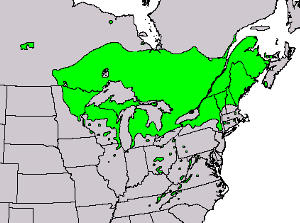
Range of Thuja Occidentalis
They are an interesting tree in terms of dendrochronology as well.
The Gynosperm database reports http://www.conifers.org/cu/th/occidentalis.htm
"The oldest living cedar that we have lives on a cliff face and
it germinated in 952 A.D. (i.e. 1051 years old). This was determined
from a cross-dated tree-ring count back to 1039 A.D. plus an
estimated 87 years lost from the pith area. The oldest dead white
cedar I've found had a tree-ring count of 1,653 years. This is a
pith date from the base. Another white cedar with a ring count of
1,567 years was estimated to be missing 323 rings from its base,
thus an estimated age of 1,890 years" (Kelly and Larson 1997,
and P.E. Kelly e-mail 15-Nov-2002).
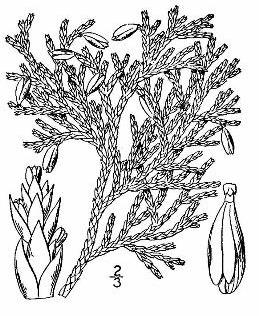
Thuja Occidentalis
American Forests lists as its national champion a specimen 255
inches in girth, 76 feet tall, with a spread of 42 in Allegheny,
Virginia. Those numbers of course are unconfirmed. The ENTS listing
for the species has a maximum height of 86 feet in the Porcupine
Mountains State Park of Michigan by Frelich and Jost, and a maximum
girth of 186 inches in South Island, Michigan. by Ernie Ostuno
and lee Frelich http://www.nativetreesociety.org/fieldtrips/michigan/manitou/south_manitou_island.htm
The specimens that caught my attention however, were not that
impressive of a size or age. I drove past the old Rumbarger Cemetery
in Dubois on a weekly basis. In the back portion of the cemetery
were a series of arborvitae of respectable size, so I stopped last
evening and measured several of them.
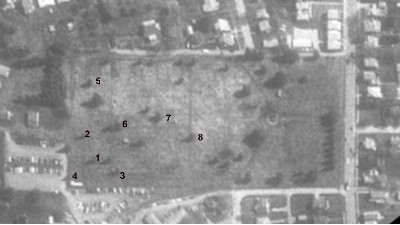
Rumbarger Cemetery, Dubois, PA
They were generally similar in size, were open grown, and likely
were planted in the same time frame. The map above denotes the
location of trees I measured. Some other moderate sized spruces are
present in this area, but were not measured. There are also perhaps
another dozen or so smaller but still good size arborvitae in the
lot that were not measured.
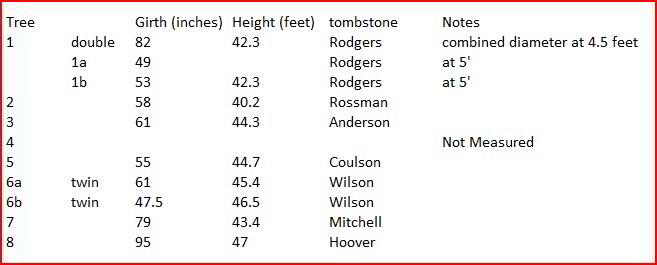
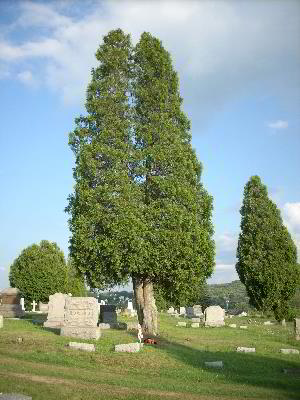
Tree #1 |
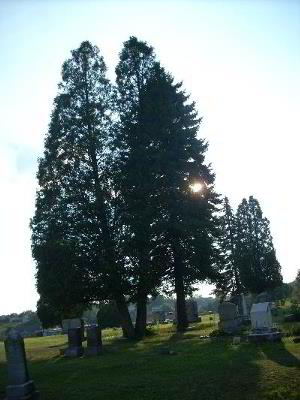
Tree #6a and 6b |
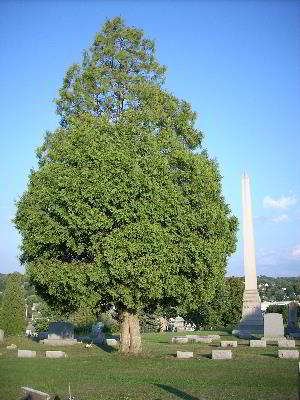
Tree #7 |
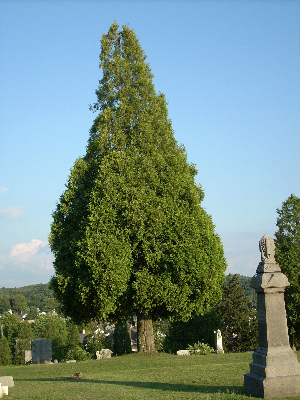
Tree #8, the largest specimen in the cemetery. |
This is, as I said not a major discovery, but I thought I would
pass on a note about this small trip and encourage others to post
about their minor adventures in tree explorations.
Ed Frank
== 2 of 3 ==
Date: Wed, Aug 13 2008 12:53 pm
From: zacstew@bellsouth.net
Ed,
Nice discovery. I've had a recent fascination with conifers,
especially the eastern native species. Cemeteries often contain very
interesting and sizable trees like these. I need to get out and
search for some nice cemetery trees myself one of these days! There
are plenty of large cemeteries around here, and at least from the
road they look like promising places to explore. And of course, I'm
very interested in genealogy and such as well.
~ Zac
==============================================================================
TOPIC: Arborvirtea
http://groups.google.com/group/entstrees/browse_thread/thread/7b57ce25a79d7286?hl=en
==============================================================================
== 1 of 2 ==
Date: Thurs, Aug 14 2008 6:05 am
From: pabigtrees
ENTS
Northern white-cedar, eastern white-cedar, arborvitae, and swamp-
cedar. The name arborvitae or "tree of life" dates from
the 16th
century when the French explorer Cartier learned from the Indians
how
to use the tree's foliage to treat scurvy. He was very sick from
scurvy when the Native Americans brewed a tea using the leasves of
the
tree and it cured him. Arborvitae is rich in vitamin C, so Cartier
called it Arbor-tree vitae- of life.
Then he started a jewelry company, just kidding.
Scott
== 2 of 2 ==
Date: Thurs, Aug 14 2008 8:25 am
From: "Edward Forrest Frank"
ENTS,
Here is some more information on the Cemetery itself:
Clearfield County Comprehensive Plan
2006 Update
http://www.planning.clearfieldco.org/Comprehensive_Plan/7_Chapter_4_-_History__Resource_Invent___Preservation_Plan.pdf
44. Rumbarger Cemetery
In the 1890s, the DuBois Cemetery Association designed and developed
a parcel of land in the Rumbarger settlement (now N. Main Street)
for a cemetery to serve the early settlers. It was known as the
"DuBois Cemetery," but due to its location, was always
referred to as Rumbarger Cemetery. Because of the shortage of land,
this cemetery survived for a very short period of time. It reached
its limitations and with no provisions for perpetual care, the
cemetery fell into slow disrepair, standing in a state of near
abandonment for many decades. Through the perseverance and
never-ending hard work of the late Mr. Wallace W. Lindsay of DuBois,
assisted in earlier years by Adrian Bakas and Ed Heffner, the old
"Rumbarger" was transformed from an eyesore of overgrown
brush, trees, and litter to reveal a neat well-groomed cemetery the
citizens of DuBois can be proud of. One of the greatest
accomplishments of these efforts was to uncover the G.A.R. circle
complete with a bronze plaque inset into a stone marker and a twin
pair of Civil War cannons believed to be the only two of their kind
in the State.
(I will note that many other volunteers also helped clean out the
brush from the cemetery, myself included, but are not credited in
any of the documents. Certain people seem to want all the credit for
the work.)
Ed Frank
|